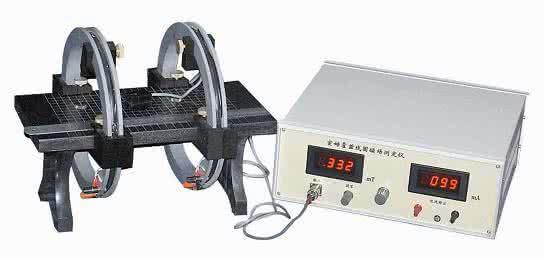Surface Magnetism
- Concept: Surface magnetism is the magnetic induction at a point on the surface of a magnet (then the center and the edge are different), and is the value measured by a Gauss meter in contact with a surface of the magnet, not the magnetic properties of the magnet as a whole.
- MEASUREMENT: Measuring the magnet's table magnetism is generally done with a Gauss meter, also called a Tesla meter. Different manufacturers have different Hall sensing elements in their Gauss meters, so the magnetization of the same magnet will be measured differently. In addition, it should be noted that different countries use different gauss meter measurement standards.
- Table magnetism and the magnet's height to diameter ratio (magnet height to diameter ratio), the larger the value of the height to diameter ratio table magnetism higher, that is, perpendicular to the magnetization direction of the larger the surface area, the lower the table magnetism; magnetization direction of the larger size, the higher the table magnetism.

Magnetic flux (common gauss meter)
Magnetic flux
- Concept: In a uniform magnetic field with magnetic induction B, there is a plane with area S and perpendicular to the direction of the magnetic field. The product of the magnetic induction B and the area S is called the magnetic flux through the plane, abbreviated as magnetic flux, with the symbol “Φ”, and the unit is Weber (Wb). Magnetic flux is a physical quantity that represents the distribution of the magnetic field, and is a scalar quantity, but has a positive and negative value, the positive and negative value only represents its direction. Φ=B-S, when there is an angle θ between S and the vertical plane of B, Φ=B-S-cosθ

(Diagram of magnetic flux)
- The magnitude of the magnetic flux through a given plane can be visualized by the number of lines of magnetic inductance passing through that plane. In the same magnetic field, the greater the magnetic induction, the denser the lines of magnetic inductance. Therefore, the larger the B and the larger the S, the greater the magnetic flux, meaning the more lines of magnetic induction pass through the plane. If there are two magnetic fluxes in opposite directions across a plane, the combined flux is the algebraic sum of the fluxes in opposite directions.
- Measurement: The flux meter is an instrument for measuring magnetic flux, which needs to be matched with a measuring coil (copper wire with a diameter of 0.1-0.5). In recent years, domestic manufacturers of permanent magnets have widely used Helmholtz coils to test their products in batches (Helmholtz coils are devices that create a uniform magnetic field in a small area. Due to the open nature of the Helmholtz coil, it is easy to put other instruments in or out, but also can be done directly visual observation, so it is a device often used in physical experiments. (Named for the German physicist Hermann von Helmholtz.)
)

(Helmholtz coils and flux meters)
Residual magnetism
- Concept: Residual magnetism refers to the magnetic induction strength retained in a ferromagnet when the external magnetic field is used to magnetize the magnet to saturation and then gradually reduce the external magnetic field to zero, which is called residual magnetic induction strength (Br). Residual magnetism is determined by the characteristics of the magnet itself, the same magnet under specific conditions, residual magnetism is constant, with a single value.
- The relationship between remanent magnetism and apparent magnetism: both are measured in Gauss, but there is no correspondence between apparent magnetism and remanent magnetism, i.e., two magnets with the same remanent magnetism may not have the same magnitude of apparent magnetism, which is affected by the magnet's shape, size, and magnetization mode.
(1) Two magnets with the same shape, performance and size are exactly the same, the one with higher remanent magnetization will have stronger remanent magnetization.
(2) Two magnets with different shapes, properties and sizes cannot simply determine the size of the remanent magnetization by the magnitude of the surface magnetization.
- The relationship between remanent magnetization and magnetic flux: when the magnetic circuit of the magnet is closed, a flux meter can be used to measure the magnetic flux and then calculate the remanent magnetization. br = φ/n/s, where: φ represents the magnetic flux, n represents the number of turns of the coil, and s represents the cross-sectional area of the magnet.











